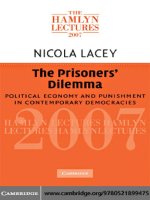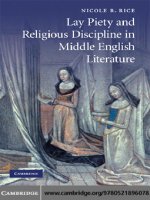cambridge university press thomas aquinas on the passions a study of summa theologiae 1a2ae 22 48 apr 2009 kho tài liệu bách khoa
Bạn đang xem bản rút gọn của tài liệu. Xem và tải ngay bản đầy đủ của tài liệu tại đây (1.79 MB, 329 trang )
This page intentionally left blank
THOMAS AQUINAS ON THE PASSIONS
The Summa theologiae is Thomas Aquinas’ undisputed masterwork,
and it includes his thoughts on the elemental forces in human life.
Feelings such as love, hatred, pleasure, pain, hope, and despair were
described by Aquinas as “passions,” representing the different ways
in which happiness could be affected. But what causes the passions?
What impact do they have on the person who suffers them? Can
they be shaped and reshaped in order to promote human flourishing? The aim of this book is to provide a better understanding
of Aquinas’ account of the passions. It identifies the Aristotelian
influences that lie at the heart of the Summa Theologiae, and it enters
into a dialogue with contemporary thinking about the nature of
emotion. The study argues that Aquinas’ work is still important today,
and shows why for Aquinas both the understanding and the attainment of happiness require prolonged reflection on the passions.
robert miner is Associate Professor of Philosophy at Baylor
University.
THOMAS AQUINAS ON
THE PASSIONS
A Study of Summa Theologiae 1a2ae 22–48
ROBERT MINER
CAMBRIDGE UNIVERSITY PRESS
Cambridge, New York, Melbourne, Madrid, Cape Town, Singapore, São Paulo
Cambridge University Press
The Edinburgh Building, Cambridge CB2 8RU, UK
Published in the United States of America by Cambridge University Press, New York
www.cambridge.org
Information on this title: www.cambridge.org/9780521897488
© Robert Miner 2009
This publication is in copyright. Subject to statutory exception and to the
provision of relevant collective licensing agreements, no reproduction of any part
may take place without the written permission of Cambridge University Press.
First published in print format 2009
ISBN-13
978-0-511-51795-2
eBook (NetLibrary)
ISBN-13
978-0-521-89748-8
hardback
Cambridge University Press has no responsibility for the persistence or accuracy
of urls for external or third-party internet websites referred to in this publication,
and does not guarantee that any content on such websites is, or will remain,
accurate or appropriate.
Contents
List of figures
List of tables
Acknowledgments
A note on the texts
page vii
viii
ix
xi
Introduction
1
part 1 the passions in general
11
1
The sensitive appetite
13
2
The definition of passion
29
3
The activation of passion
58
4
The morality of the passions
88
part 2 particular passions: the concupiscible
passions
109
5
Love
6
Hatred and concupiscence
140
7
Pleasure
160
8
Sorrow
188
111
part 3 particular passions: the irascible passions
9
Hope and despair
213
215
10 Fear
231
v
Contents
vi
11
Daring
252
12
Anger
268
Epilogue: The passions, the virtues, and happiness
Bibliography
Index
287
300
308
Figures
The narrative structure of the concupiscible passions
The passions as ordered pairs (coniugationes )
Appetition follows sense apprehension
Appetition follows sensation and imagination
The estimative power, activated by sensation and
imagination
3.4 Passions in the order of generation: a simple scheme
3.5 Passions in the order of generation: adding
sorrow and anger
3.6 Passions in the order of generation: a “final” diagram
2.1
2.2
3.1
3.2
3.3
vii
page 42
54
67
69
74
83
84
86
Tables
1.1 Types of soul, activities, modes of living
3.1 The concupiscible passions according to their
formal objects
3.2 The irascible passions (except for anger) according
to their formal objects
5.1 The particular passions in order of appearance
in the 1a2ae
Ep.1 Moral virtues in relation to the objects of the
passions
viii
page 14
61
62
113
294
Acknowledgments
I am pleased to thank the National Endowment for the Humanities for
awarding me a 2005 Summer Stipend. I am also grateful to Baylor University
for a sabbatical in spring 2005. The generosity of both institutions was
instrumental to progress in research.
Learning about the passions comes not only from reading, but also
from conversing with friends. Discussions with David and Elizabeth
Corey have been a constant source of inspiration and renewal. I am glad
to acknowledge a special debt to Margaret Watkins, who read the entire
manuscript and whose insights have improved the whole. Thanks are also
due to the decanal side of the Honors College, Thomas Hibbs and Alden
Smith, and to my colleagues in Great Texts: Scott Moore, Barry Harvey,
Peter Candler, Phillip Donnelly, Michael Foley, Doug Henry, Sarah-Jane
Murray, Amy Vail, and William Weaver.
Over and above my colleagues at Baylor, I wish to thank the exceptionally inquisitive students in the Honors College. Teaching them has
contributed much to my understanding of Thomas Aquinas and sacra
doctrina. Their willingness to read an initially forbidding author, and to
respond to him in unpredictable and creative ways, has taught me much.
Various forms of support in and around Baylor have been provided by
the following individuals: Michele Anderson, Katharine Boswell, AnneMarie Bowery, Darin Davis, Paulette Edwards, Jeff Fish, Doris Kelly, Bob
Kruschwitz, Mark Long, Luis Noble, Anna Shaw, Haley Stewart, Daniel
Stewart, and Amanda Weppler. Beyond Waco, I wish to thank Michael
Barrett, David Burrell, Kerry Cronin, Rebecca DeYoung, Greg MacIsaac,
Sean McCrossin, Paul McNellis, Giuseppe Mazzotta, Christian Moevs,
Kevin Ormand, David Solomon, Lou Solomon, John Stroup, Ronald
Tacelli, Jason Taylor, and John von Heyking. Special acknowledgment is
due to Mark Jordan. I am profoundly grateful for his encouragement over
the years to read and teach Thomas Aquinas.
ix
x
Acknowledgments
Editorial guidance of a particularly valuable kind was provided by Kate
Brett of Cambridge University Press. I appreciate her early and unstinting
support for the project. I am also grateful to Nicholas Healy and Robert
Pasnau, who read the manuscript for the Press. Both made insightful
comments and suggestions that led to substantive improvements and the
avoidance of any number of mistakes. The errors that remain are the ones
I cannot bear to abandon.
Most of all, I am grateful for the constant support of my parents, Mary
Miner and Bob Miner. Thanks also to Christopher Miner, Meredith
Miner, Morgan Miner, Laura Lusk, Brad Lusk, Tammy Miner, and
Jeanette Moseley.
Finally, but in no sense as an afterthought, I should like to acknowledge
the blessing of my children: Anne, Sebastian, Sophia, Emma, Maria, Louisa,
and Lily. All seven have provided occasions for insights into all the passions,
but especially love, prima radix omnium passionum.
A note on the texts
References to ST 1a2ae cite the question, article, and portion of article
(e.g. 35.3.co).
References to other parts of ST are the same, except that an initial part
number is prefixed (e.g. 1.78.4.co).
References to InDA, InNE, InMet, and InPh cite the book number of
the Aristotelian text, followed by numerals referring to the lectio and the
paragraph divisions as they appear in Alarco´n’s editions.
Unless indicated otherwise, I am working with the Latin texts as
established by Enrique Alarco´n, whose electronic version of Aquinas’
opera omnia, published at www.corpusthomisticum.org, is the most complete, accurate, and up-to-date edition that currently exists. Alarco´n has
taken over where Roberto Busa left off. Readers of Aquinas everywhere are
indebted to both men.
All translations of Aquinas’ texts are my own. Latin nouns that appear
in the text have generally been converted to their nominative forms, unless
they appear within a clause with their grammatically correct cases.
The following titles of Aquinas’ texts are cited by these abbreviations:
InDA
InMet
InNE
InPh
QDA
QDM
QDV
ST
Sententia libri De anima
Sententia libri Metaphysicae
Sententia libri Ethicorum
In libros Physicorum
Questiones disputae de anima
Questiones disputatae de malo
Quaestiones disputate de veritate
Summa theologiae
1a ¼ first part; 1a2ae ¼ first part of second part, etc.; pr. ¼ prologue; arg.
N ¼ Nth argument or “objection”; sc ¼ argument sed contra; co ¼ body of
article; ad Nm ¼ reply to the Nth argument.
PL and PG refer to J.-P. Migne, Patrologia latina and Patrologia graeca
(see Bibliography).
xi
Introduction
why read thomas aquinas on the passions?
Five of the greatest modern thinkers – Descartes, Hobbes, Spinoza,
Hume, and Rousseau – take the passions as a primary theme in their
major works. This is required, it seems, by the task of developing a new
mechanistic account of human nature that is compatible with the mechanism of the new science and the new politics. But to what conception
of the passions are these thinkers responding? What account of the
passions do the architects of modernity judge it necessary to criticize
and replace? Directly or indirectly, modern thinkers are responding to
the non-mechanistic, teleological conception of the passions articulated
by Thomas Aquinas in Questions 22–48 of the 1a2ae of the Summa
theologiae, the so-called “Treatise on the Passions.”1 Today we speak more
frequently of “the emotions” than of the passions. But contemporary
discourses about the emotions, which strongly emphasize their role as
the springs of many (if not all) of our actions, descend directly from the
fundamental psychological innovations of the seventeenth century (see
Rosenkrantz 2005, p. 214). Consequently, Aquinas’ work on the passions
constitutes no small part of the background against which both early
modern discussions of the passions and recent talk about the emotions
must be understood.
The above constitutes one answer to the question: Why study Aquinas
on the passions? The answer may satisfy those who sense that the concept
of “the emotions” taken for granted by many recent philosophers and
psychologists has a history, and cannot be understood apart from that
1
Here and elsewhere, I occasionally acquiesce in the practice of referring to 1-2. 22–48 as the “Treatise
on the Passions.” I hasten to add that I am using “treatise” under erasure, since Thomas does not,
strictly speaking, write treatises. Jordan (1994) observes: “The Summa is not built out of treatises,
but out of clusters of Questions caught up into larger and larger rhythms of investigation” (p. 471).
1
2
Introduction
history. (For one provocative genealogy, see Thomas Dixon’s From Passions
to Emotions: The Creation of a Secular Psychological Category [2003].) But
what about those who are convinced that modern neuroscience has
uncovered the essential mechanisms of the emotions, and that historical
investigation has little to contribute to genuine understanding of the
emotions, regardless of its capacity to illuminate pre-scientific thought?
It is unlikely that members of this class would be persuaded to read
Aquinas, or even Hume, unless they were convinced by a very different
argument for the importance of thinking about the passions in a manner
that is not dictated by the latest advances in neuroscience. A recent book
by Robert Roberts offers one such argument. Modern scientific thinking
illuminates the physical substructure of the emotions, often in novel and
compelling ways. But information about the physical substructure of
emotions does little, if anything, to clarify how, when, why, and by
whom humans become angry, jealous, sad, or embarrassed. Roberts
makes an analogy to the distinction between the human experience of
music and its acoustical substructure. “Physically speaking, music is
nothing but temporally extended and divided sequenced mixtures of
air vibrations of various frequencies and amplitudes or, alternatively,
mixtures of atmospheric compression wave trains of varying wavelengths
and amplitudes” (2003, pp. 52–3). A competent physicist can give an
exact acoustical account of a piece of music, delineating its mathematical
substructure in precise terms. Such an account, while useful for any
number of purposes, is not the same as understanding a piece of music
as a musician understands it. Musicians “hear and speak of melodies,
harmonies and counterpoint, rhythms, themes and their development,
musical structure, dynamics, evocation and musical meanings, phrases,
cadences, dissonances and resolutions of dissonances, and much more. It
is only incidentally and occasionally that they hear and speak of frequencies, amplitudes, and wavelengths” (p. 53). Similarly, a purely
neurological explanation of emotions, no matter how advanced and
accurate, cannot substitute for, or compete with, an account given “in
terms of the person’s concerns, beliefs, thoughts, perceptions, personal
history, present situation, and other factors” (p. 53).
If Roberts is right about this – and I think he is – it follows that
contemporary neuroscience is not an alternative to an account of the form
given by Aquinas, that is, one that analyzes the passions in terms of their
human significance rather than their physiological mechanisms. This
argument eliminates one motive that a contemporary reader might have
for avoiding Aquinas. Yet it does little to show that Aquinas merits
Why read Thomas Aquinas on the passions?
3
particular attention. For Roberts, the demonstration that neuroscientific
accounts of emotion are necessarily limited in scope is a way of clearing
the ground for “conceptual analysis” of the emotions. As Roberts understands it, conceptual analysis is primarily a matter of attending to experienced emotional phenomena, making appropriate distinctions and
generalizations. It proceeds from “observations that ordinary emotional
subjects can make simply by being intelligent and observant human
beings” (2003, p. 59). For this enterprise, sustained engagement with the
history of philosophy is, at best, ancillary. At one point in his book,
Roberts notices a proposal by Martha Nussbaum about the Stoic account
of emotion, but avoids prolonged discussion on the ground that he is
“concerned more with substantive questions than those of historical
scholarship” (2003, p. 83).
This neat divide between “substantive questions” and “historical
scholarship” is questionable. It assumes a single, stable category of “the
emotions” on which the analyst can go to work, without much attention
to the concept’s history. Though he interestingly argues that the particular
things divided by Paul Griffiths (“affect programs,” “higher cognitive
emotions,” and “emotional pretenses”) are interrelated, Roberts assumes
the prior existence of “the emotions” as a stable category, invulnerable to
historical change, which others can attempt to “fracture.” But what if
one was never persuaded that “the emotions” are either historically or
transcendentally basic? Suppose one takes the more plausible view that
“the emotions” are a descendant from seventeenth-century discourses on
passions, which in turn are constituted as reactions to medieval conceptions of the passiones. In that case, it appears that Roberts and others who
take “the emotions” for granted exemplify what Ame´lie Rorty calls “the
historical innocence of most philosophical analyses of the emotions”
(1984, p. 522).
Such innocence leads contemporary practitioners of conceptual analysis
to assume not only the existence of an unchanging subject-matter
designated by “the emotions,” but also the essential value of their own
discussions. Both assumptions are questionable. Rorty finds the historical
innocence of conceptual analysis of the emotions to carry certain consequences. “To put it bluntly,” she writes,
current philosophical debates about the passions and emotions seem to stand
even further away from the phenomena they are meant to illuminate than
philosophical discussions normally do. We seem to be engaged in ill-formed
and unresolvable polemical debates. What is even more puzzling is that the very
questions we address seem, on the face of it, bizarre and factious, guaranteed to
4
Introduction
generate arbitrary and factitious discussions. Officially we are preoccupied with
determining whether emotions can be evaluated for their rationality; or whether
they are voluntary; or whether they can be “reduced” to cognitions; or whether
they are interruptions of behavior that is normally purposeful. But in fact we
know better: when we are really thinking, rather than making pronouncements,
we know that we evaluate the appropriateness of emotions by criteria that are
much richer than those of logical consistency: we are interested in determining
whether they are inadequate or excessive, crude or subtle; whether they are
harmoniously balanced with one another; whether we admire the character
traits they reveal and the motives that usually accompany them. And when we
are careful, we usually also distinguish passions, emotions, affects, sentiments.
(1984, pp. 521–2)
This passage suggests at least two more reasons to read Aquinas on the
passions. First, it is not clear how to “distinguish passions, emotions,
affects, sentiments.” Aquinas speaks frequently of passiones and occasionally of affectiones, but never of “emotions.” What is the difference? If “the
emotions” emerge only as the end product of a long history that involves
multiple transformations of the concepts of pathe, passiones, and passions
(see Rorty 1984, p. 545), one must first know what the passions are.
Reading Aquinas on the passiones is one way to accomplish this goal.
(It should be clear the practice of translating passiones by “emotions,”
rather than “passions,” is misleading, since it necessarily obscures the
question about the relation between passions and emotions.)
Second, one may share Rorty’s sense that despite their technical
sophistication, most current discussions of the emotions lack existential
interest.2 One may discover sources of relief from this condition in the
history of philosophy. Of contemporary philosophical writers on the
emotions, the one who has most illuminated the path toward such relief
is Martha Nussbaum. What makes Nussbaum’s writing so powerful is not
primarily her powers of analysis, but her ability to draw upon primary
texts in the history of philosophy. Precisely because of her deep engagement with such texts, along with her willingness to test their insights with
“real-life” examples, Nussbaum’s work escapes Rorty’s charge of sterility
and irrelevance. Nussbaum draws liberally from Plato and Aristotle, more
heavily from the Stoics, a little from Dante, and not at all from Aquinas.
In this work, I wish to draw upon Aquinas, keeping Nussbaum’s work in
mind as an exemplary reminder that subtle exegesis of historical texts can
2
See, for instance, Roberts 2003: “the defining proposition for romantic love as an emotion is: She
(he) is mine and I am hers (his); she (he) is uniquely wonderful and sexually attractive; we belong
together forever” (pp. 291–2; italics in original).
Why read Thomas Aquinas on the passions?
5
have both intellectual power and human relevance.3 Aquinas’ view of the
passions, I will show, incorporates elements of the Stoic philosophy,
whose appreciation Nussbaum urges. Moreover, it has two key advantages
over Stoicism. First, Aquinas understands, no less acutely than the Stoics,
the central place of intentional apprehension in the activation of the
passions. Yet he does not simply identify the passions with judgments,
as the Stoics do. Second, whereas Nussbaum has to work very hard to
combine the insights of Stoicism with the position that the emotions
play an important role in human life and ought not to be eliminated,
Aquinas’ awareness of Augustine’s adjudication of the debates between the
Peripatetics and the Stoics enables him to articulate the same position
naturally and without strain.
Why should one read Aquinas on the passions? I have given several
reasons: to avoid scientistic (not scientific) reductionism, to escape historical innocence, to grasp the problematic relation between “passion” and
“emotion,” to think about the passions without severing the connection to
life. I have not mentioned the most obvious reason – to improve our grasp
of Aquinas’ thought. One might suppose that students of Aquinas, or at
least his ethics, would not require a commentary on the “Treatise on the
Passions.” Yet the surprising truth is that Questions 22–48 of the 1a2ae of
the Summa theologiae are among the most neglected in his corpus.
Nothing is more commonplace for readers of Aquinas, and especially of
what has come to be known as his “moral theology,” than to pay close
attention to the Questions on happiness, virtue, and natural law in the
1a2ae. For many of the same readers, nothing is more habitual than to
skim through, or skip entirely, the “Treatise on the Passions.” This neglect
has not gone entirely unnoticed. Servais Pinckaers observes that the
twenty-seven Questions containing 132 Articles on the passions comprise
“une oeuvre unique, classique . . . et trop ne´glige´e” (1990, p. 379).
Pinckaers’s observation raises a simple question: Why are Questions 22–
48 of the 1a2ae so strangely neglected?4
One might propose an answer in terms drawn from Aquinas himself.
Ethics is the study of human actions, their ends, and their principles. The
passions, as Thomas himself says, are not properly human actions – that is,
3
4
Some thoughtful comparisons between Nussbaum and Aquinas may be found in Leget 2003.
Solomon 2002 offers an insightful review of Nussbaum’s Upheavals of Thought, commenting that
“it is the literary and historical dimensions that make the book a special contribution to the now
burgeoning literature on the emotions” (p. 898).
See Amis 1954, pp. 14–15.
6
Introduction
free acts of the will – but acts that human beings have in common with
other animals. However intriguing Thomas’s analysis of the non-rational
side of humanity, it has no direct relevance to moral matters, understood as the study of properly human action. D. M. Pru¨mmer, in
his Manuale Theologiae Moralis, treats the passions under the heading
De hostibus voluntarii, as “obstacles to the voluntary character of human
actions” (quoted in Pinckaers 1990, p. 380). In treating the passions
thus, Pru¨mmer undoubtedly took himself to proceed ad mentem sancti
Thomae.
Is this a genuinely Thomist approach to the passions? As Pinckaers has
shown with consummate elegance, the “manualist” adaptations of what is
taken to be Thomist moral theology are not so much faithful translations
as grotesque distortions of Aquinas’ thinking, usually with a pronounced
“Kantian” flavor. Pinckaers contrasts the ancient conception of ethics as a
response to the question of happiness with the manuals that “gravely
make ethics revolve around the question of obligations” (1990, p. 380).
Thomas begins the 1a2ae with an inquiry into happiness, considered as the
ultimate end for human beings. Ethics is, above all, the study of what
human beings need to know in order to attain happiness. Anything
belonging to the consideration of moral matters in general that constitutes
the 1a2ae is meant to serve this end.
Nothing could be more alien to Aquinas than the habit of ignoring the
passions because they are (allegedly) irrelevant to morals. Just as modern
readers of Aquinas’ doctrines about being and knowing have often
approached these doctrines with questions of essentially Kantian provenance, and thus distorted his thinking, so many students of the pars moralis
of the ST have similarly misconstrued his notions about ethics. The error
is not limited to readers of fifty years ago who would focus on natural law
as though it were a sufficient guide to rational morality. It includes more
recent scholars who see the importance of virtue for Aquinas’ conception
of ethics, but proceed as though virtue were perfectly intelligible without a
prior grasp of the passions.
Does understanding the virtues require a prolonged study of the
passions? An affirmative answer to this question is not self-evident. What
is clear, however, is that Aquinas does not suppose that the virtues can
be approached without a thorough grounding in the passions. There is
nothing accidental about the architecture of either the ST as a whole, or
the 1a2ae in particular. The 1a2ae treats the end of human life and what is
necessary to attain that end. Questions 1–5 treat the end; Questions 6–48
treat the acts required to attain the end; Questions 49–114 treat the
Why read Thomas Aquinas on the passions?
7
principia, interior and exterior, of those acts. Within the consideration of
the acts, the main division is between “acts of the will” (Questions 6–21)
and the “acts in common with animals” that Aquinas identifies as the
passions (Questions 22–48). Why does Aquinas accord twice as many
Questions to the acts in common with animals as he does to distinctively
human acts?5 The question is sharpened when one remembers that in the
ST Aquinas does not devote space to idle Questions. As the Prologue of
that work reminds us, he writes with pedagogical concerns in mind.
He wants to avoid the multiplication of useless questions, articles, and
arguments, as well as the frequent repetition that brings weariness and
confusion to the souls of students. Why, then, should a consideration of
moral matters in universali include so many Questions on the passions,
prior to the treatment of the virtues?
By the time Aquinas comes to write the ST, he is convinced that
knowing the passions is fundamental for understanding the rational
creature’s quest for beatitude. But why? We should know about the
passions, one might think, because they are powerful forces that impede
reason and thereby frustrate the attempts of human beings to live wisely
and happily. But Aquinas does not take this line. In his judgment, what
kills the progress of the rational creature toward the end is not passion but
sin. One may persist – Thomas treats the passions at length because
protection against sin requires a knowledge of its causes. Passion can
indeed be a cause of sin. But it is not only a cause of sin. Moreover, it is
neither the unique nor the most potent cause of sin. No reasoning that
terminates in a solely negative justification for treating the passions at
length can be reconciled with Thomas’s thought.
To understand why Aquinas privileges the passions as he does in the
ST, the reader must grasp what he teaches about the passions in that text.
That is, she must encounter the ST ’s actual teaching. Such an encounter
makes any number of demands on the reader. It requires some knowledge
of Aquinas’ auctoritates : not only Aristotle and Augustine, but also
Dionysius and Damascene, Scripture and Cicero. It requires attention
to the four Questions about the passions in general. Finally, and most
importantly, it requires a careful reading of the twenty-three Questions
that treat of the particular passions.
5
Uffenheimer-Lippens (2003) accurately observes that the Questions on the passions comprise nearly
a quarter of the 1a2ae (p. 530). Pinckaers (1990) makes a similar observation, noting that the
Questions on the passions outnumber those on happiness and human acts, as well as those on
the virtues and the gifts, or law and grace.
8
Introduction
The aim of this book is to facilitate an encounter with Thomas
Aquinas’ teaching on the passions, as we have it in its most detailed
elaboration.6 But what does it mean to grasp any particular teaching of
the ST ? Is it adequate to select isolated passages that appear to offer
definitions of the passions, or to focus mainly on passages that seem
relevant to contemporary concerns? While such methods may yield
some insights, they are not sufficient for an integral reading. In order
to perceive what Aquinas is up to in the ST, the reader must adopt a
different approach. She must attend closely to each Question in the
Treatise, following the steps of its articulation. Initially, I was convinced
that the natural correlate of close reading was article-by-article exposition
of each Question. I still have sympathy with this approach, especially
when the goal is to set forth a detailed and comprehensive reading of
the text that avoids doing violence to its form. But since contemporary
readers will inevitably find some questions more pressing than others,
and since there is no reason to believe that the priorities of such
readers will correspond to Aquinas’ own, I have not strictly adhered to
an articulatim approach.7 Instead, I have adopted the following procedure. In Part 1 of the book, I treat topics in a logical sequence that
contemporary readers should find intelligible. I ask about the sensitive
appetite in general, proceed to a consideration of its acts (i.e. the
passions), inquire into the various things that arouse these acts, and
conclude with a consideration of Aquinas’ thought on the relation
between the passions and morality. Here I follow Aquinas’ order in a
broad sense. The initial delineation of the sensitive appetite focuses on
the 1a pars; the analysis of the other topics switches to Aquinas’ consideration of the passions in general, which comprises Questions 22–5 of the
1a2ae. Since recent commentary on the passions tends almost exclusively
6
7
The ST is not the only work in which Aquinas addresses the passions. Other texts include the
Scriptum on Peter Lombard’s Sentences (bk. 3, dist. 26), the Quaestiones disputatae de veritate
(Questions 25 and 26), the Quaestiones disputatae de malo, and the expositio of Aristotle’s
Nicomachean Ethics. In this book, I am not concerned to provide comprehensive readings of
these texts; I attend to them only as they are useful for illuminating the teaching of the ST.
On this point I am grateful to Robert Pasnau, who convinced me that strict adherence to the
articulatim approach might limit the audience of this book to the small class of readers who are
seeking a literal commentary on 1-2.22–48. Some may still judge that Parts 2 and 3 preserve too
much of this approach. But in light of the intrinsic relation between what Aquinas thinks about a
particular passion, and the rhetorical form of his treatment, I think the benefits of this procedure far
outweigh the liabilities. On the dangers of abstracting the “teachings” of a thinker from the forms of
the texts in which those teachings are conveyed, see Jordan 1992b.
Why read Thomas Aquinas on the passions?
9
to emphasize these questions, the proportion of dialogue with other
interpreters of Aquinas’ thought and contemporary thinkers who write
about “the emotions” is relatively high in the four chapters that comprise
Part 1.
Parts 2 and 3 adopt a different approach. I begin Part 2 with an
argument for the proposition that in order to achieve any serious understanding of Aquinas’ thinking about the passions, Questions 26–48
must be privileged. Part 2 focuses on the “concupiscible” passions treated
in Questions 26–39; Part 3 examines the “irascible” passions that
Aquinas discusses in Questions 40–8. In both parts, I take the view
that grasping what Aquinas thinks about any particular passion, and
why he thinks it, requires careful attention to the form and mode of
treatment – that is, to the distribution of Questions corresponding to any
particular passion, and to the organization of Articles within any given
Question. Though not every Question and every Article receives equal
emphasis, my basic procedure in these two parts is to follow the thread
that informs the individual Questions and Articles devoted to the
particular passions. This means that Parts 2 and 3 have a different
character from Part 1. Some readers who find Part 1 philosophically
interesting may wonder about the importance of Parts 2 and 3. Conversely, those who find Parts 2 and 3 to the point may have reservations
about the mode of approach characteristic of Part 1. My hope is that
readers will find each part beneficial, recognizing that a treatment of the
passions “in general” will naturally have a different character from a serial
examination of particular passions. (Some such difference, I think,
informs Aquinas’ own treatment.)
If Part 1 interacts with a range of contemporary writers, Parts 2
and 3 engage in a sustained dialogue with one commentator in particular, Santiago Ramı´rez. Ramı´rez’s De passionibus animae, the transcript of a series of lectures he gave in Latin during the middle of the
last century, is one of the few recent commentaries on the whole of
the Treatise. In forming my own interpretations, I have found Ramı´rez’s
treatment quite helpful, notwithstanding my disagreement with many of
his specific claims. I have especially benefited from his persistent attempts to ferret out the ordo articulorum (“order of articles”) that comprises the spine of any given Question in the ST. Ramı´rez’s attempts
in this area typically propose an ordo articulorum that coincides with a
logical distinction familiar to Thomas (e.g. “per se causes” vs. “per
accidens causes”). Eschmann observes that “a strictly ‘logical’ scheme,
such as that of Ramı´rez, is simply too narrow for the rich and abundant
10
Introduction
Thomistic text” (1997, p. 41).8 He acknowledges, however, that Ramı´rez is
“very keen and not infrequently successful in analyzing the logic of Saint
Thomas’s proceedings” (p. 58). I think that Eschmann is right on both
counts.
Umberto Galeazzi observes that any present inquiry into Aquinas’
thinking on the passions is “inevitably conditioned” by our relation to
“modern and contemporary thought” (2004, p. 548). This is true, I think,
yet it remains a worthwhile goal to attempt to understand Aquinas as he
understood himself, for reasons not merely antiquarian in character. In
asserting the contemporary relevance of Aquinas, I do not mean to suggest
that he already says everything that one would want to know about the
passions. Some students of Aquinas, impressed by the power of his
thought, the amplitude of his interests, and his personal sanctity, suppose
that the answer to any significant question is somehow contained within
his texts, either implicitly or explicitly. Since I am myself impressed with
Aquinas on all three counts, I understand the temptation to make this
supposition. But it should be resisted. Aquinas is simply not in a position
to address some questions of contemporary interest. What is the precise
relation between the distinguishable forms of fear that are manifested in
specific autonomic responses and the reactions in various regions of the
brain, especially the amygdala? Pressing Aquinas on such questions is not
a profitable use of his texts. Modern neuroscience has much to tell us
about the passions that Aquinas was unable to know.9 Yet it remains
possible that Aquinas offers a conceptual framework in which the findings
of modern neuroscience may be integrated. Despite our distance from the
Middle Ages, we have plenty of reasons to encounter Aquinas’ account
of the passions, an analysis “pre´cise, de´taille´e, bien articule´e et relie´e
a` l’ensemble, un petit chef-d’oeuvre a` la manie`re des e´difices du temps”
(Pinckaers 1990, p. 381).
8
9
On the tendency to assimilate Thomas’s textual structures to a quasi-mathematical order, the
following warning of Pascal remains apposite: “Je sais un peu ce que c’est, et combien peu de
gens l’entendent. Nulle science humaine ne le peut garder. Saint Thomas ne l’a pas garde´.
La mathe´matique le garde, mais elle est inutile en sa profondeur” (1976, §61, p. 63; see also
Pascal 1966, §694, p. 246).
Here Kenny (2004) strikes the right balance. One may admit that some of Aquinas’ views have been
“superannuated by the progress of science,” while proceeding to acknowledge (as Kenny does a
paragraph later) that “Aquinas was an intellectual giant, and those of us who try to interpret him to
a twenty-first century audience are like Lilliputians trying to tie him down with our own conceptual
netting” (p. 462).
part 1
The passions in general









